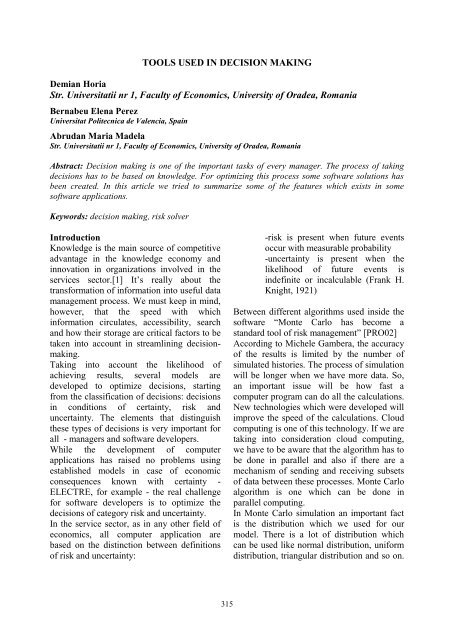Selected papers~ SPECIAL EDITION - Index of
Selected papers~ SPECIAL EDITION - Index of
Selected papers~ SPECIAL EDITION - Index of
Create successful ePaper yourself
Turn your PDF publications into a flip-book with our unique Google optimized e-Paper software.
TOOLS USED IN DECISION MAKING<br />
Demian Horia<br />
Str. Universitatii nr 1, Faculty <strong>of</strong> Economics, University <strong>of</strong> Oradea, Romania<br />
Bernabeu Elena Perez<br />
Universitat Politecnica de Valencia, Spain<br />
Abrudan Maria Madela<br />
Str. Universitatii nr 1, Faculty <strong>of</strong> Economics, University <strong>of</strong> Oradea, Romania<br />
Abstract: Decision making is one <strong>of</strong> the important tasks <strong>of</strong> every manager. The process <strong>of</strong> taking<br />
decisions has to be based on knowledge. For optimizing this process some s<strong>of</strong>tware solutions has<br />
been created. In this article we tried to summarize some <strong>of</strong> the features which exists in some<br />
s<strong>of</strong>tware applications.<br />
Keywords: decision making, risk solver<br />
Introduction<br />
Knowledge is the main source <strong>of</strong> competitive<br />
advantage in the knowledge economy and<br />
innovation in organizations involved in the<br />
services sector.[1] It’s really about the<br />
transformation <strong>of</strong> information into useful data<br />
management process. We must keep in mind,<br />
however, that the speed with which<br />
information circulates, accessibility, search<br />
and how their storage are critical factors to be<br />
taken into account in streamlining decisionmaking.<br />
Taking into account the likelihood <strong>of</strong><br />
achieving results, several models are<br />
developed to optimize decisions, starting<br />
from the classification <strong>of</strong> decisions: decisions<br />
in conditions <strong>of</strong> certainty, risk and<br />
uncertainty. The elements that distinguish<br />
these types <strong>of</strong> decisions is very important for<br />
all - managers and s<strong>of</strong>tware developers.<br />
While the development <strong>of</strong> computer<br />
applications has raised no problems using<br />
established models in case <strong>of</strong> economic<br />
consequences known with certainty -<br />
ELECTRE, for example - the real challenge<br />
for s<strong>of</strong>tware developers is to optimize the<br />
decisions <strong>of</strong> category risk and uncertainty.<br />
In the service sector, as in any other field <strong>of</strong><br />
economics, all computer application are<br />
based on the distinction between definitions<br />
<strong>of</strong> risk and uncertainty:<br />
315<br />
-risk is present when future events<br />
occur with measurable probability<br />
-uncertainty is present when the<br />
likelihood <strong>of</strong> future events is<br />
indefinite or incalculable (Frank H.<br />
Knight, 1921)<br />
Between different algorithms used inside the<br />
s<strong>of</strong>tware “Monte Carlo has become a<br />
standard tool <strong>of</strong> risk management” [PRO02]<br />
According to Michele Gambera, the accuracy<br />
<strong>of</strong> the results is limited by the number <strong>of</strong><br />
simulated histories. The process <strong>of</strong> simulation<br />
will be longer when we have more data. So,<br />
an important issue will be how fast a<br />
computer program can do all the calculations.<br />
New technologies which were developed will<br />
improve the speed <strong>of</strong> the calculations. Cloud<br />
computing is one <strong>of</strong> this technology. If we are<br />
taking into consideration cloud computing,<br />
we have to be aware that the algorithm has to<br />
be done in parallel and also if there are a<br />
mechanism <strong>of</strong> sending and receiving subsets<br />
<strong>of</strong> data between these processes. Monte Carlo<br />
algorithm is one which can be done in<br />
parallel computing.<br />
In Monte Carlo simulation an important fact<br />
is the distribution which we used for our<br />
model. There is a lot <strong>of</strong> distribution which<br />
can be used like normal distribution, uniform<br />
distribution, triangular distribution and so on.


